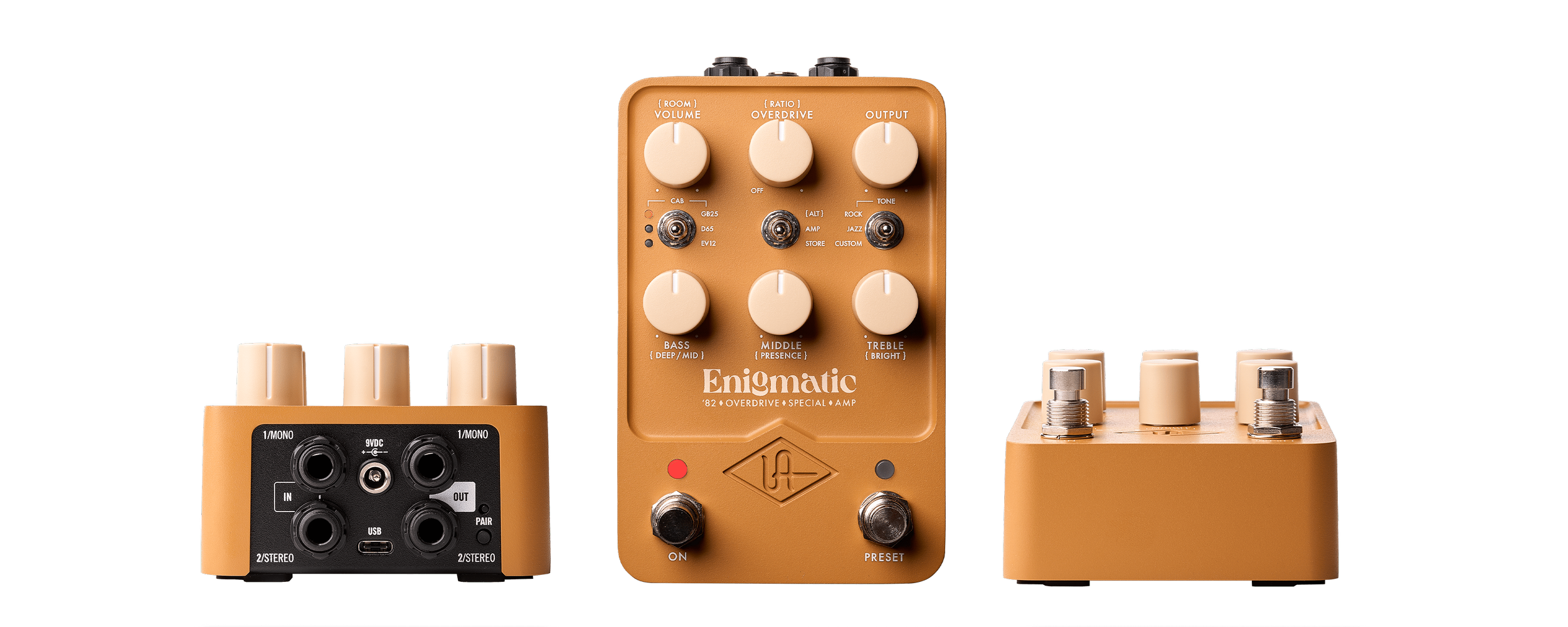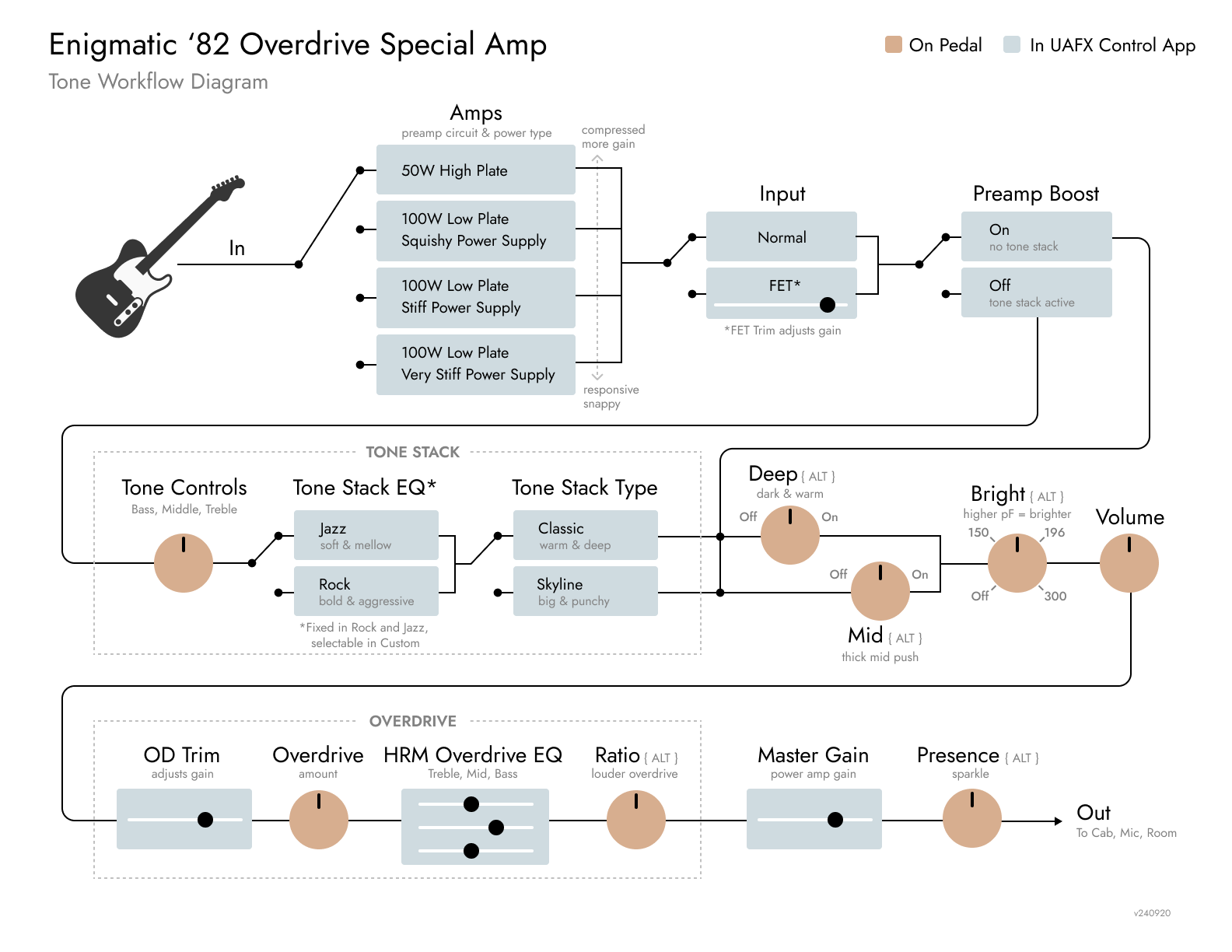Review : Universal Audio Enigmatic ‘82 Overdrive Special Amp - The Best Dumble Amp that you can afford?
Welcome to 2025 everyone. I hope that your New Year was an excellent event and I send my best wishes for peace and happiness to all of you for all of 2025.
The Dumble Thing
Alexander Howard Dumble was born in 1939 and passed in 2022. He was an amplifier designer and an extremely skilled amplifier technician. His work revolved around making highly custom amplifiers for select clients and he rarely worked on more than a few each year after founding Dumble Amplifiers in the early 1960s. While most guitarists have heard of Dumble, and perhaps have heard of the two distinct families of Dumble amplifiers, the Overdrive Special and the Steel String Singer, unless you have been very fortunate, a massive star or have a monstrous pile of cash, you’ve likely never played through a Dumble and the likelihood of owning one is a probability accelerating towards zero.
Dumble’s circuits are unique and he commonly covered them with epoxy to prevent the circuits from being visible and readily copied. While there are Dumble clones, in reality a clone is a clone of a single amplifier and anyone with experience with these grail amplifiers will tell you that model name notwithstanding, every Dumble is different from every other one. Dumble was a tweaker, constantly making changes to his designs, so two Overdrive Specials might be similar but never identical
As result of their scarcity, and the sound delivered by superb guitarists such as Carlos Santana, Eric Clapton, Stevie Ray Vaughan, Robben Ford and John Mayer, Dumbles have attained legendary status. Some would say that this is frequently overblown and I would tend to agree. In the right hands, with the right player, the sound from the amplifier can be magical. Would a Dumble make someone like myself sound brilliant? Not a chance. The amplifier is but one of many elements in the player’s chain, and no amp, guitar, or effects device will make you a better player. You will still be you, perhaps with a different tone.
Dumble Alternatives
Since I don’t have well over a hundred grand for a great Dumble, I content myself with alternatives that deliver the sound of the amplifier that I hear on recordings. I don’t ignore at all the talent of the player, the other elements and the skills of the engineer and producer on those recordings, but to my ears, a Dumble does sound different from other excellent USA designed and built amplifiers. The most common methodology of doing this is via models made from actual amplifiers. These models are most often made by recording existing Dumbles, but a short analysis will often show that the preamp and power amp are real where the speaker and cabinet are something else entirely. You have to try a lot and then decide what you like best. If you are considering a software based model, I do like the Dumble pack, available as an add-on purchase for the IK Multimedia TONEX pedal.
Universal Audio Amplifiers
At first take, you would be correct to say that Universal Audio does not make amplifiers and in the classic sense, that would be true. However, Bill Putnam Sr. was an audio genius and Bill Putnam Jr. has continued to keep the company focus on building tools that do what professionals really want. UA plugins behave like the real hardware and while I own excellent plugins from a number of providers, when I want the actual sound of real gear, invariably I end up with a UA plugin in my mixing and mastering steps.
A few years ago, UA applied their capabilities to amplifier re-creations. They brought in some really brilliant people to drive this including James Santiago and Tore Mogensen who left TC Electronic to come to UA. The Woodrow ‘55 was their first amp pedal and whether you call it an amp or amp emulator, it sounds and behaves like 1955 Fender Tweed Deluxe model 5D3. This was followed in fairly short order by the Ruby ‘63 Top Boost, a very accurate take (in my opinion, the most accurate take) on the 1963 VOX AC30 and the Dream ‘65 Reverb, a superb recreation of the 1965 Fender Blackface Deluxe Reverb. This was later followed by the Lion ‘68 Super Lead, which has for me, eliminated the need to mike up my ‘72 Marshall Custom Super Lead for recording. Then in 2024, UA dropped three new amp pedals; the ANTI 1992 High Gain, the Knuckles ‘92 Dual Rectifier, and the pedal I write about today, the Enigmatic ‘82 ODS
The Enigmatic ‘82 ODS
Straight up, I will admit to being an advocate and recommender of the UA amps. I find them superbly usable and while their normal home is on the desk in the studio, I also will regularly connect one to an FRFR cabinet and turn them up loud. If you want to then say that I have a bias in favour of the UA amps, you are free to do so, because it’s to some extent true.
The name says it all. This pedal is a creation that emulates a 1982 Overdrive Special. Contrary to some YouTube misstatements, it does not emulate any Steel String Singer amps.
It does however offer a number of variants on the ODS which gives the player a very wide tonal spectrum. The pedal also offers a custom mode that allows the player to build a custom Dumble style amplifier mixing and matching components.
Enigmatic ‘82 Tone Workflow
You will note immediately that you can play the Enigmatic ‘82 right out of the box. There are six easy to use knobs that accomodate normal human sized fingers and an ALT switch that enables secondary functions. While many players never read the documentation, there is so much here, that you should. The pedal will also connect via Bluetooth to the UAFX Control App on your iPhone or iPad for deeper levels of control or customization. Also when you register your pedal, you get additional speaker/cabinet options. I highly recommend getting and using the UAFX Control App. Please bear in mind that while UA says that the app is available for both iOS and Android, there is an enormous amount of negative feedback in the marketplace about the Android version being unstable and very difficult to sustain a connection. Also I will tell you from personal experience, if you have questions or issues, try the UA User Forums because UA Support, to be blunt, needs a lot of work to rise to the level of crappy. The forum is by contrast quite good and UA folks actually spend a fair bit of time on there.
Speaker / Cabinet Options
How Does It Sound?
The Enigmatic ‘82 is like all the other UA Amps. It does not run on batteries and it requires an AC power supply. Note though that your cheapo power string supply will probably not work because the Enigmatic ‘82, like the other UA amps, requires 9v at 400mA. Since most pedals that do not use digital signal processing only need 100mA, get yourself a decent power supply. I recommend and use the power supply systems from CIOKS. Others will probably work but I only recommend that which I have used and paid for with my own money.
The Enigmatic ‘82 supports mono or stereo inputs and outputs. As I will often use a stereo effect in front of an amp, or go wet dry, I like this alot. As noted earlier, my primary use case is in the studio so each output goes to its own track in the DAW. If you want to use an alternate speaker/cab/mic/room emulation you can turn it off in the app, and I have done this with other UA amps and used the OX Stomp to provide those services. For the most part however, when I am looking for the “Dumble sound” I use one of the D options in the pedal itself.
Sample Tones
It’s realy hard to demo an amp for me. There are just so many options. For this short series of clips, I plugged my PRS NF3 directly into the Enigmatic ‘82 and from there to the inputs on a UA Apollo and recorded into UA LUNA. LUNA was left completely bare, no preamps, no EQ, nothing. The first is the amp set to clean using the middle pickup. The second is the amp set to single coil edge of breakup with the guitar volume rolled off and the bridge pickup used. The third is the same amp setting but using the neck pickup and the volume turned back up to 8. The final is the amp set for heavy overdrive with the bridge pickup only. These barely scratch the surface of what this amp can do and I am not really happy with my results because the recording doesn’t convey the massive headroom and unique tonality that this amp can deliver. More work required on my part and I ran out of time. So it goes.
Wrapping Up
Current course and speed, I will never play through a Dumble, let alone own one. Of all the Dumble models I have tried and there have been lots, this amp sounds the best to me. Is it exactly like a real Dumble? I cannot tell because there is no Dumble here to compare it with. What I can say is that it sounds and more importantly responds differently to my picking hand than other amps. It’s also, to be blunt, considerably less forgiving. I think that’s a good thing, but not every one will agree. However, if your position is similar to mine, it’s definitely worth trying out and it’s portability makes it outstanding. I used no pedals in front of it and no effects in production, so what you hear is what is there, given the sound from that particular guitar.
If you like what I do here for you, please become a supporter on Patreon. Your monthly contribution makes an enormous difference and helps me keep things going. To become a Patreon Patron, just click the link or the button below. Thanks for your support of my work. I’m Ross Chevalier and I look forward to sharing with you again soon.



